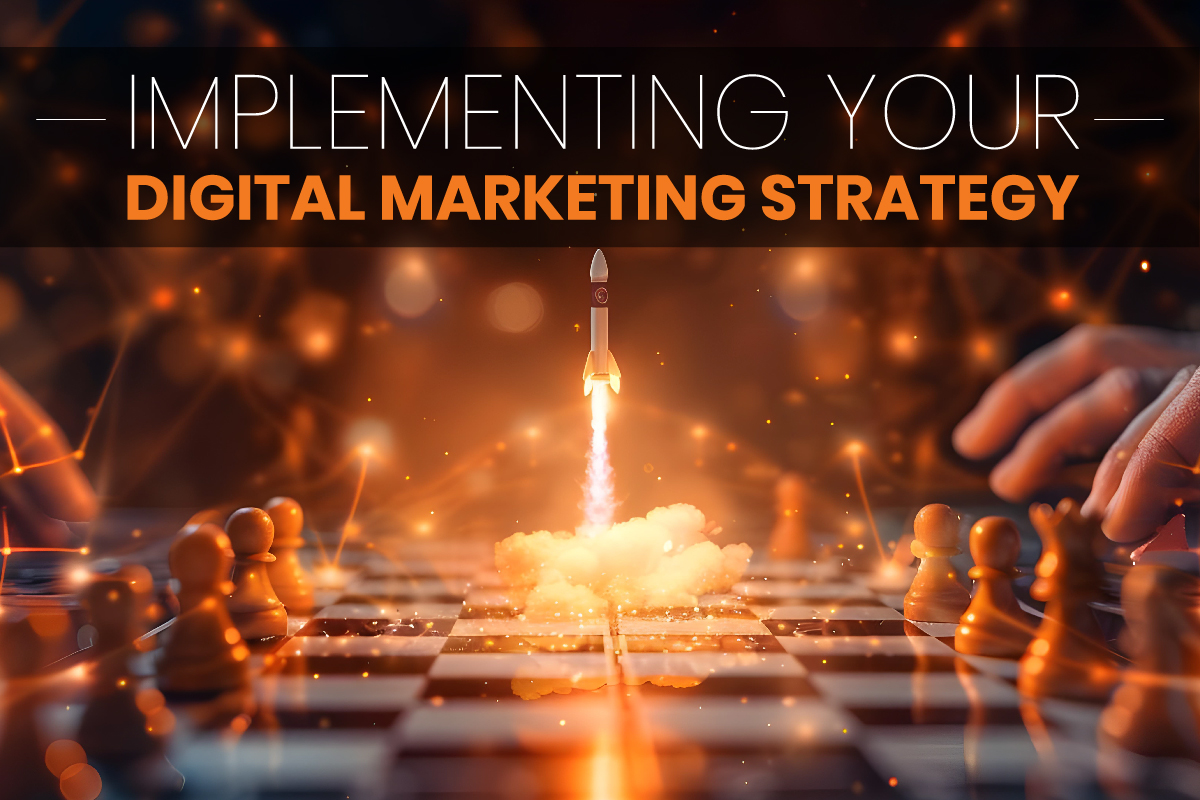In the digital era, businesses must adapt to rapidly changing online landscapes to thrive and outpace competitors. Consequently, a robust digital marketing strategy is no longer optional—it’s essential for success. At Grayling & Wraith, we understand that crafting a successful digital marketing strategy requires precision, adaptability, and an in-depth understanding of the online environment. Therefore, this comprehensive guide explores the critical components of a digital marketing strategy, offering actionable insights to help your business succeed in the digital world.
What is a Digital Marketing Strategy?
A digital marketing strategy is a comprehensive plan designed to promote a business’s products or services online. It involves using various digital channels—such as search engines, social media, email, and websites—to connect with current and prospective customers. Unlike traditional marketing methods, a digital marketing strategy allows for targeted messaging and real-time interaction, providing a more personalized customer experience. To understand the foundations of digital marketing, you can refer to this overview by the Digital Marketing Institute.
Importance of a Digital Marketing Strategy
A well-defined digital marketing strategy is crucial for aligning your marketing efforts with your business goals. It optimizes the use of resources, enhances customer engagement, and ultimately increases return on investment (ROI). Moreover, a solid strategy provides valuable insights into consumer behavior, enabling businesses to make data-driven decisions and adjust their marketing plans accordingly. The Content Marketing Institute offers great insights into why content is a key component of any digital marketing strategy.
- Achieving Business Goals: A digital marketing strategy is aligned with your broader business objectives, ensuring that every marketing activity contributes towards these goals. For example, if your goal is to increase brand awareness, your strategy might focus on content marketing and social media engagement.
- Efficient Resource Allocation: By outlining a clear strategy, businesses can allocate their marketing resources—time, budget, and manpower—more efficiently. Consequently, this prevents waste and ensures that resources are directed towards high-impact activities.
- Enhanced Customer Engagement: Digital marketing strategies allow businesses to engage with customers across various touchpoints. By utilizing platforms like social media, email, and mobile apps, companies can interact with customers in real-time, thereby building relationships and fostering loyalty.
- Informed Decision-Making: A digital marketing strategy provides a framework for analyzing performance and making data-driven decisions. With the ability to track key metrics, businesses can refine their strategy to improve effectiveness and achieve better results.

Key Components of a Digital Marketing Strategy
- Goals and Objectives: Defining clear, measurable goals is the first step in any digital marketing strategy. Whether aiming to increase brand awareness, generate leads, or drive sales, setting specific objectives helps track and measure success. SMART goals are widely recommended for effective planning.
- Target Audience: Identifying and understanding your target audience is essential. Knowing who your customers are allows you to tailor your messaging and select the most effective channels to reach them.
- Competitive Analysis: Analyzing your competitors’ digital marketing strategies offers insights into industry trends and helps identify opportunities to differentiate your brand. For more on competitive analysis techniques, HubSpot’s guide can be a valuable resource.
- Value Proposition: Clearly defining what makes your product or service unique and why customers should choose you over competitors is crucial. This value proposition should be evident across all marketing channels and messaging.
- Content Plan: Content is the fuel that drives digital marketing strategies. A well-thought-out content plan includes the type of content to be created, the platforms on which it will be distributed, and the frequency of publication. The Content Marketing Institute provides comprehensive resources on developing effective content strategies.
Crafting a Successful Digital Marketing Strategy
Creating an effective digital marketing strategy involves a structured approach, starting from research and planning to implementation and evaluation. Each step is crucial for developing a strategy that resonates with your target audience and achieves your business objectives.
Research and Planning
Research and planning form the foundation of a successful digital marketing strategy. It involves understanding the market landscape, customer behavior, and competitor activities.
Market Research
Conducting thorough market research helps businesses understand the industry landscape, identify customer needs, and spot market trends. This research can include analyzing competitors, conducting customer surveys, hosting focus groups, and reviewing industry reports. Consequently, these insights guide the development of a digital marketing strategy that aligns with market demands and customer expectations. Statista offers a wealth of data that can be useful for market research.
- Understanding Industry Trends: Staying informed about the latest trends in your industry can provide a competitive advantage. This involves regularly reviewing industry reports, following thought leaders, and participating in relevant webinars and conferences.
- Analyzing Customer Behavior: Using tools like Google Analytics, businesses can gain insights into how customers interact with their website, what products or services they are interested in, and what factors influence their purchasing decisions. Consequently, this information is invaluable for tailoring your digital marketing strategy to meet customer needs.
- Competitor Analysis: Understanding what your competitors are doing can reveal opportunities and threats. Analyze their marketing tactics, website performance, content strategy, and social media presence to identify areas where you can differentiate your brand.
Setting SMART Goals
Setting SMART (Specific, Measurable, Achievable, Relevant, Time-bound) goals provides a clear path to achieving your marketing objectives. For instance, rather than aiming to “increase website traffic,” a SMART goal would specify “increasing website traffic by 30% within the next six months.” This specificity allows for better tracking and evaluation of your strategy’s effectiveness. More about SMART goals can be found at Smartsheet.
- Specific: Goals should be clear and specific. Instead of a vague goal like “improve social media presence,” a specific goal would be “gain 5,000 new followers on Instagram in the next three months.”
- Measurable: Ensure that the goals can be measured. Use metrics such as website traffic, conversion rates, or social media engagement to track progress.
- Achievable: Set realistic goals that can be achieved with the available resources and time. Setting overly ambitious goals can lead to frustration and burnout.
- Relevant: Goals should align with your business objectives. For example, if your business objective is to increase sales, a relevant marketing goal would be to improve lead conversion rates.
- Time-bound: Goals should have a clear deadline. This creates a sense of urgency and helps keep the team focused and motivated.

Identifying Your Target Audience
Understanding your target audience is crucial for tailoring your digital marketing strategy. By knowing your customers’ demographics, preferences, and behaviors, you can create personalized and relevant marketing messages, thereby enhancing engagement and effectiveness.
Creating Buyer Personas
Buyer personas are semi-fictional representations of your ideal customers, based on market research and real data about your existing customers. By developing detailed personas, you can better understand the specific needs, challenges, and behaviors of different segments of your audience, thereby allowing for more targeted and effective marketing efforts. The Buyer Persona Institute provides useful resources for creating effective personas.
- Gathering Data: Collect data from various sources such as customer surveys, website analytics, and social media insights. Look for common characteristics among your most valuable customers.
- Identifying Pain Points: Understand the challenges and pain points your customers face. This information can help you create content that addresses these issues and positions your brand as a solution.
- Mapping Customer Journeys: Map out the journey your customers take from awareness to purchase. Understanding this journey helps in creating content and campaigns that guide customers through each stage of the buying process.
Segmenting Your Audience
Audience segmentation involves dividing your target market into distinct groups based on specific criteria such as demographics, interests, behavior, or buying habits. This segmentation enables businesses to deliver more personalized and relevant content, enhancing customer engagement and conversion rates. A comprehensive guide on audience segmentation can be found on Qualtrics.
- Demographic Segmentation: This involves segmenting your audience based on factors such as age, gender, income, education, and occupation. Demographic data helps in tailoring your messaging to resonate with specific groups.
- Behavioral Segmentation: Segmenting based on behavior focuses on how customers interact with your brand, their purchasing habits, and their loyalty status. Behavioral insights can be used to create targeted campaigns for different segments, such as frequent buyers or first-time customers.
- Psychographic Segmentation: This involves segmenting based on lifestyle, values, attitudes, and interests. Understanding what motivates your audience and what they value helps in creating content that resonates on a deeper level.

Implementing Your Digital Marketing Strategy
With a solid foundation in place, the next step is to implement your digital marketing strategy. This involves selecting the appropriate channels, creating engaging content, and using digital marketing tools to enhance efficiency and effectiveness.
Choosing the Right Marketing Channels
Not all digital marketing channels are equally effective for every business. The choice of channels should be based on where your target audience is most active and where you can achieve the greatest impact.
Search Engine Optimization (SEO)
SEO is the practice of optimizing your website and content to rank higher on search engine results pages (SERPs). It involves keyword research, on-page optimization, and building high-quality backlinks. As a long-term strategy, SEO drives organic traffic, enhances brand visibility, and builds credibility. For a deeper understanding of SEO, consider checking out Moz’s Beginner’s Guide to SEO. Additionally, for strategies tailored to smaller businesses, see our SEO Strategies for Small Businesses article.
- Keyword Research: Identifying the right keywords is crucial for SEO success. Use tools like Google Keyword Planner, Ahrefs, and SEMrush to find keywords relevant to your business. Focus on both short-tail and long-tail keywords to capture a broad range of search queries, such as “digital marketing strategy for small businesses.”
- On-Page Optimization: On-page SEO involves optimizing individual web pages to improve their search engine rankings. Key elements include optimizing title tags, meta descriptions, headings, and content for target keywords like “effective digital marketing strategies.” Ensure that your website’s structure is logical, with clear navigation and fast loading times. For tips on on-page SEO, Neil Patel’s blog is an excellent resource.
- Technical SEO: Technical SEO focuses on improving the technical aspects of your website to enhance its search engine visibility. This includes optimizing site speed, ensuring mobile-friendliness, using structured data markup, and improving site architecture.
- Link Building: Building high-quality backlinks from authoritative websites signals to search engines that your site is trustworthy and relevant. Implement a link-building strategy that includes guest blogging, outreach, and creating shareable content. For more on link-building, Backlinko’s guide is a great place to start.
- Local SEO: For businesses targeting a local audience, optimizing for local search is crucial. This involves claiming your Google My Business listing, optimizing for local keywords, and building local citations.
Social Media Marketing
Social media platforms provide businesses with opportunities to connect with their audience, build brand awareness, and drive traffic. Each platform has its unique features and demographics, making it important to choose the ones that align with your business goals. Consequently, selecting the right platforms can significantly enhance your marketing strategy’s effectiveness. To learn more about developing a robust content strategy for social media, check out our Organic Social Media: Develop Your Brand’s Content Strategy article.
- Platform Selection: Choose platforms based on where your target audience spends their time. For example, LinkedIn is ideal for B2B marketing, while Instagram and TikTok are popular among younger, visually oriented-audiences.
- Content Strategy: Develop a content strategy that includes a mix of promotional, educational, and entertaining content. Use visuals, videos, and interactive content to engage your audience. Regularly monitor engagement metrics to understand what content resonates most with your audience. Sprout Social provides great tools for managing and optimizing social media strategies.
- Paid Advertising: Social media advertising allows for highly targeted campaigns. Use features like Facebook Ads Manager and LinkedIn Ads to target specific demographics, interests, and behaviors. Set clear objectives for your campaigns, such as lead generation, website traffic, or conversions. Hootsuite’s guide on social media advertising can be a valuable resource.
- Community Building: Engage with your audience by responding to comments, participating in conversations, and creating a community around your brand. This fosters loyalty and encourages user-generated content.
- Influencer Marketing: Partnering with influencers who align with your brand can help reach a wider audience and build trust. Choose influencers who have a genuine connection with your target audience and can authentically promote your brand.
Email Marketing
Email marketing remains a powerful tool for engaging with customers and driving conversions. It allows for personalized communication and nurturing relationships with your audience.
- List Building: Build a high-quality email list by offering valuable content, such as e-books, webinars, or discounts, in exchange for email sign-ups. Use sign-up forms on your website, social media, and other touchpoints. For list-building strategies, Campaign Monitor offers useful insights.
- Segmentation: Segment your email list based on criteria such as demographics, purchase history, and engagement levels. This allows for targeted and personalized email campaigns that are more likely to resonate with recipients.
- Personalization: Use customer data to personalize email content, addressing recipients by name and tailoring content to their interests and behavior. Personalized emails have higher open and click-through rates.
- Automation: Use email marketing automation tools to send timely and relevant messages. Automated campaigns can include welcome emails, abandoned cart reminders, and post-purchase follow-ups. Automation saves time and ensures consistent communication. Learn more about automation from Mailchimp’s guide.
- A/B Testing: Experiment with different email elements, such as subject lines, images, and call-to-actions, to see what resonates best with your audience. A/B testing helps optimize email performance and improve conversion rates.

Creating Engaging Content
Content is the cornerstone of any digital marketing strategy. High-quality, relevant content attracts and retains customers, driving them to take desired actions.
Developing a Content Calendar
A content calendar helps organize and schedule content across various platforms. It ensures consistency, provides a clear overview of upcoming content, and helps align your content with marketing campaigns and key dates. CoSchedule’s blog provides valuable tips on creating effective content calendars.
- Content Types: Diversify your content to keep your audience engaged. Include blog posts, videos, infographics, podcasts, and social media posts. Each content type serves a different purpose and engages your audience in unique ways.
- Frequency: Determine the frequency of your content publication. Regularly updating your blog and social media channels keeps your audience engaged and improves SEO. However, focus on quality over quantity; it’s better to post less frequently if it means maintaining high standards.
- Editorial Guidelines: Establish editorial guidelines to ensure consistency in tone, style, and messaging. This helps maintain a cohesive brand image across all content.
- Seasonal Content: Plan content around holidays, seasons, and industry events. Seasonal content can capitalize on current trends and increase relevance.
- Repurposing Content: Repurpose existing content into different formats, such as turning a blog post into a video or infographic. This extends the life of your content and reaches different segments of your audience.
Types of Content
- Blog Posts: Blogging is an effective way to drive organic traffic to your website and establish your brand as an industry authority. Focus on creating informative, engaging, and SEO-optimized blog posts that address the needs and interests of your target audience. The HubSpot Blog is a useful resource for tips on effective blogging.
- Videos: Video content is highly engaging and effective for conveying information quickly and clearly. Use videos to showcase products, share customer testimonials, provide tutorials, or create behind-the-scenes content. Platforms like YouTube and social media channels are ideal for video marketing. To learn more about video marketing, refer to Wistia’s guide.
- Infographics: Infographics visually represent information, making complex data easy to understand. They are shareable and can be used to explain processes, present statistics, or summarize key points from longer content pieces. Venngage’s blog offers tips and templates for creating impactful infographics.
- Podcasts: Podcasts are a growing medium for reaching audiences. They offer a platform to share expert insights, interviews, and industry trends. A well-produced podcast can build a loyal following and enhance brand authority.
- E-books and Whitepapers: These long-form content pieces are valuable for lead generation and establishing thought leadership. They provide in-depth information on complex topics and can be used to capture email leads.
Utilizing Digital Marketing Tools
Leveraging digital marketing tools enhances the efficiency and effectiveness of your strategy. These tools help automate tasks, analyze data, and optimize your marketing efforts.
Analytics and Reporting
Data analysis is essential for understanding the performance of your digital marketing strategy. Tools like Google Analytics provide insights into website traffic, user behavior, and conversion rates, thereby allowing you to make informed decisions and optimize your strategy effectively.
- Website Analytics: Monitor key metrics such as page views, bounce rate, average session duration, and conversion rates. These metrics provide insights into how visitors interact with your website and highlight areas for improvement.
- Social Media Analytics: Track engagement metrics such as likes, shares, comments, and followers to understand the effectiveness of your social media campaigns. Use tools like Facebook Insights and Twitter Analytics to gain insights into your audience and content performance.
- Email Marketing Analytics: Monitor open rates, click-through rates, and conversion rates to measure the effectiveness of your email campaigns. Use A/B testing to experiment with different subject lines, content, and call-to-actions to improve performance. For more on email marketing analytics, Mailchimp’s guide is a helpful resource.
- Conversion Tracking: Use tools like Google Tag Manager to track conversions and understand the customer journey. This helps in optimizing landing pages and improving conversion rates.
- Customer Feedback: Use surveys and feedback forms to gather insights directly from your customers. Tools like SurveyMonkey can help collect and analyze customer feedback to improve your digital marketing efforts.
Automation Tools
Marketing automation tools streamline repetitive tasks, saving time and improving efficiency. They also allow for personalized communication, increasing engagement and conversion rates.
- Email Automation: Use email marketing platforms like Mailchimp and HubSpot to automate email campaigns. Set up automated workflows for welcome emails, drip campaigns, and re-engagement emails.
- Social Media Automation: Tools like Hootsuite and Buffer allow for scheduling and publishing social media posts in advance. Automation ensures consistent posting and frees up time for other marketing activities.
- CRM Automation: Customer Relationship Management (CRM) tools like Salesforce and Zoho CRM automate customer interactions, track leads, and manage sales pipelines. They provide valuable insights into customer behavior and help personalize marketing efforts.
- Chatbots: Implement chatbots on your website to provide instant customer support and answer common queries. Chatbots can improve customer satisfaction and free up time for your support team.
- Lead Scoring: Use automation tools to score leads based on their interactions with your website and content. This helps prioritize high-quality leads and improves sales efficiency.

Measuring the Success of Your Digital Marketing Strategy
Measuring the success of your digital marketing strategy is crucial for understanding its impact and making data-driven decisions. Regular monitoring and evaluation allow you to identify areas of improvement and, consequently, optimize your strategy for better results.
Key Performance Indicators (KPIs)
KPIs are metrics that help measure the success of your digital marketing efforts. They provide insights into how well your strategy is performing and highlight areas that need attention.
Website Traffic
Monitoring website traffic is essential for understanding the effectiveness of your SEO and content marketing efforts. Use tools like Google Analytics to track the number of visitors, page views, and referral sources. Analyzing traffic data helps identify popular content, top-performing keywords, and high-converting pages.
- Unique Visitors: Track the number of unique visitors to understand how many individuals are visiting your site. An increase in unique visitors indicates growing brand awareness.
- Referral Traffic: Analyze referral sources to understand where your traffic is coming from, such as search engines, social media, or other websites. This helps identify which channels are most effective.
- Bounce Rate: A high bounce rate indicates that visitors are leaving your site quickly. Analyzing bounce rates helps identify pages that need improvement to keep visitors engaged.
Conversion Rates
Conversion rates measure the percentage of visitors who take a desired action, such as making a purchase, filling out a form, or signing up for a newsletter. A high conversion rate indicates that your marketing messages are resonating with your audience and encouraging them to take action.
- Lead Conversion Rate: Measure the percentage of visitors who become leads by filling out a form or subscribing to your newsletter. Improving lead conversion rates is crucial for generating sales opportunities.
- Sales Conversion Rate: Track the percentage of leads who convert into paying customers. This metric helps assess the effectiveness of your sales funnel and identify areas for improvement.
- Cart Abandonment Rate: For e-commerce businesses, monitor the cart abandonment rate to understand how many visitors are leaving without completing their purchase. Implementing strategies to reduce cart abandonment can significantly improve sales.
Social Media Engagement
Social media engagement metrics include likes, shares, comments, and mentions. Monitoring these metrics provides insights into how your audience is interacting with your content and helps identify the type of content that resonates most with your followers. For tips on improving social media engagement, Hootsuite’s blog is a helpful resource.
- Engagement Rate: Calculate the engagement rate by dividing the number of interactions (likes, comments, shares) by the total number of followers. A high engagement rate indicates that your content is resonating with your audience.
- Share of Voice: Monitor how often your brand is mentioned compared to competitors. A higher share of voice indicates stronger brand presence and awareness.
Sentiment Analysis: Use sentiment analysis tools to understand the tone of conversations about your brand. Positive sentiment indicates brand loyalty, while negative sentiment may highlight areas for improvement.

A/B Testing
A/B testing involves comparing two versions of a marketing asset to determine which one performs better. It is a valuable tool for optimizing elements such as headlines, call-to-actions, images, and landing pages.
- Headline Testing: Experiment with different headlines to see which one captures the most attention. A compelling headline can significantly impact click-through rates and engagement. Optimizely’s guide provides more on A/B testing best practices.
- Call-to-Action Testing: Test different call-to-action phrases, colors, and placements to see which one drives the most conversions. A strong call-to-action encourages users to take the next step in the customer journey.
- Image Testing: Visuals are crucial in attracting attention and conveying messages. Test different images to see which resonate most with your audience and enhance the effectiveness of your content.
- Landing Page Testing: Optimize landing pages by testing different layouts, forms, and messaging. A well-optimized landing page can significantly improve conversion rates.
- Email Testing: Experiment with different email elements, such as subject lines, send times, and content, to improve open and click-through rates.
Regularly Reviewing and Adjusting Your Strategy
The digital landscape is constantly evolving, and so should your digital marketing strategy. Regularly reviewing your performance and staying updated with industry trends is crucial for maintaining a competitive edge.
- Performance Review: Conduct regular performance reviews to assess the effectiveness of your digital marketing strategy. Analyze data, identify trends, and make adjustments based on insights gained.
- Trend Analysis: Stay updated with the latest digital marketing trends and technologies. Adapting to new trends allows you to leverage new opportunities and stay ahead of competitors. eMarketer offers up-to-date information on digital marketing trends.
- Competitor Monitoring: Regularly monitor competitors to understand their strategies and identify areas where you can differentiate your brand.
- Continuous Improvement: Digital marketing is an ongoing process of testing, learning, and optimizing. Continuously seek ways to improve your strategy, enhance customer experience, and achieve better results.
- Feedback Loops: Establish feedback loops with customers and team members to gather insights and suggestions. Continuous feedback helps refine your strategy and adapt to changing customer needs.

The Way Forward
A well-crafted digital marketing strategy is essential for businesses looking to succeed in the digital world. At Grayling & Wraith, we specialize in creating tailored digital marketing strategies that drive growth, increase brand visibility, and deliver measurable results. By understanding your target audience, selecting the right channels, creating engaging content, and leveraging digital marketing tools, you can elevate your digital marketing efforts and achieve long-term success.
Incorporating a digital marketing strategy into your business plan is not just a choice but a necessity in today’s digital world. Therefore, stay ahead of the curve by continuously optimizing and adapting your strategy, and watch your business thrive.

















